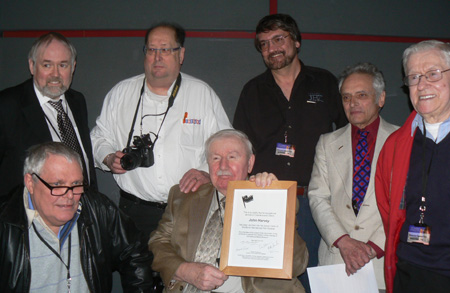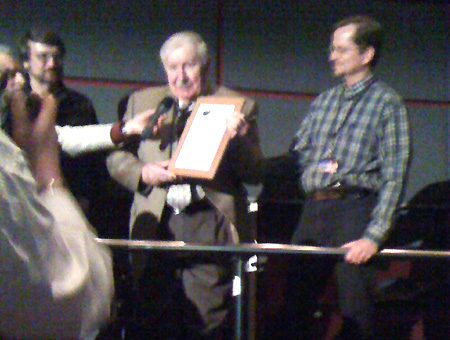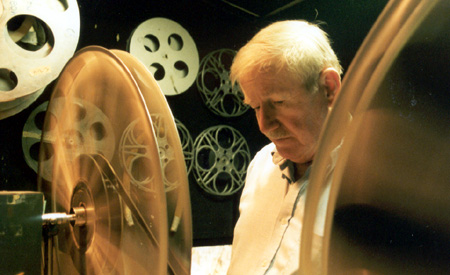2010 Academy Member
|
Read more
at in70mm.com The 70mm Newsletter |
| Written by: Richard Greenhalgh, Hollywood, USA | 28. March 2010 |
 2010
Academy picture By Robert Valkenburg 2010
Academy picture By Robert ValkenburgBack from left: Bill Lawrence, Francois Carrin, David Strohmaier, Keith Swadkins & Howard Rust Sitting: Willem Bouwmeester & John Harvey. This year’s recipient of The Academy of the Widescreen Weekend's Roll of Honor is a projectionist, phenomenal collector, showman and Cinerama enthusiast extraordinaire – a true "Keeper of the Frame." In 1946, he began following his brother to work at their local drive-in theater, the Miami Cruse-In. Here he would return weeks on end to watch Al Hill, the man who would later take him under his wing and teach him to be a projectionist. At the age of 16, then a budding projectionist, his parents took him to see "This Is Cinerama" at the Capitol Theatre in Cincinnati. In his own words, "That razor sharp image on the giant curved screen and the seven channels of discreet full-range stereo separation hit me just right. When Lowell Thomas said, "Ladies and Gentlemen, THIS IS CINERAMA," well, for me, it was a life changing event." |
Further
in 70mm reading: Widescreen Weekend 2010 Events John Harvey "Mr. Cinerama" in Bradford Academy of the Widescreen Weekend Widescreen Weekend home Internet link: |
 This year’s recipient of The Academy of the
Widescreen Weekend's Roll of Honor John Harvey. Dave Strohmaier is seen to
the left, John Harvey in the middle and Larry Smith to the right. iPhone
image by Bill Lawrence This year’s recipient of The Academy of the
Widescreen Weekend's Roll of Honor John Harvey. Dave Strohmaier is seen to
the left, John Harvey in the middle and Larry Smith to the right. iPhone
image by Bill LawrenceIn 1963, he was lucky enough to be a union projectionist when Cinerama was installed for the first time in Dayton, Ohio, at the Dabel Cinerama Theater for the 38 week run of "How the West Was Won". He was trained by Cinerama. He was there when the Cinerama technicians removed the three projectors to make room for the so-called new and improved "Super Cinerama." Our nominee continued to run movies in CinemaScope, 4-track magnetic sound, 3-D, Todd-AO and all the rest that came into being because of Fred Waller's magical idea. Of course, none of these new widescreen processes would ever satisfy his remembrance of Cinerama as being the best theatrical presentation format. As the years passed, he moved from projectionist to theater technician because, again in his own words, "I wanted to know how everything worked and how to do it better to assure the best presentation possible like I had seen Cinerama do in the fifties. Years later, in the seventies, I decided even if I had to do it all by myself, I was going to re-assemble or build from scratch the three Cinerama projectors, the seven channel stereophonic sound equipment and construct a curved Cinerama screen in my home." |
|
 Dave
Strohmaier and Keith Swadkins. Image by Mark Lyndon Dave
Strohmaier and Keith Swadkins. Image by Mark LyndonSoon this guy was spending his vacations travelling the world, scavenging parts from old theaters and junkyards and visiting technicians. He found one projector in Indianapolis, another in Europe; the third came in pieces from all over. He converted his ranch home in Dayton into his own personal Cinerama theatre. At first he only had six minutes of footage. But soon he had managed to cobble together, from upwards of 20 sources, complete and surprisingly well-preserved prints of "How the West Was Won" and "This Is Cinerama". He enjoyed sharing his Cinerama prints with friends in his living room and in 1986 Willem Bouwmeester heard about this fellow and soon he visited him in Dayton. They hit it off immediately and became instant friends. Our nominee has been unstinting in giving credit to Willem for helping to bring Cinerama back and for his abilities to track down equipment and fabricate and create the things needed. After years of planning and much work on the part of many, including Keith Swadkins and the International Cinerama Society, he arrived in Bradford the first week in March 1993 to work with Willem and the Museum staff to begin the final installation here in Bradford. On June 16, 1993, Cinerama rolled again for the fist time in 21 years at a public performance in Pictureville as a part of the tenth anniversary of the Museum. We were honored to have Mrs. Fred Waller here with us for that premiere. |
|
 Willem
Bouwmeester, Francois Carrin, Dave Strohmaier, John Harvey and Keith
Swadkins. Image by Robert Valkenburg Willem
Bouwmeester, Francois Carrin, Dave Strohmaier, John Harvey and Keith
Swadkins. Image by Robert ValkenburgMeanwhile, by the mid nineties, at the urging of his friend, Larry Smith, he brought his projectors and prints to the New Neon Theatre in Dayton. Though it used to require five skilled technicians to screen Cinerama, our nominee developed a complex yet feasible way of synchronizing the projectors so that he could run the entire show himself. On August 29, 1996, with Mrs. Lowell Thomas in attendance, film buffs from across the world lined up for the first showing of "This Is Cinerama". This was the first time it had been publically shown in America in over 32 years. For three and a half years the New Neon Theater hosted patrons from 38 states and 11 countries. After his visit, Leonard Maltin wrote: "Whew! What a weekend … and what an experience. I encourage any of you who love movies to make the Neon Movies a priority destination, while this program continues." The 1999 Cleveland International Film Festival program stated that "Leonard Maltin wants our nominee to be the first projectionist to be awarded an Oscar." Another enthusiast wrote, "We found his genuine love for these films and the Cinerama process to be simply amazing. He keeps his projectors and sound equipment in top running shape by sheer love and dedication. During the films, he kept the alignment of the seams so tight that they actually seemed to disappear. It was a real privilege to meet him and to see how these films are supposed to be shown." |
|
 John
Harvey running three strip films in Dayton, 1997. Image by Thomas
Hauerslev John
Harvey running three strip films in Dayton, 1997. Image by Thomas
HauerslevA few years later, when Microsoft millionaire Paul Allen financed the re-opening of the Cinerama theatre in Seattle, he was brought in. Those who were there, well remember how he stayed late into the night to set up their Cinerama screening. On June 2, 2000, after an early showing of "Cinerama Adventure", he ran his prints of "This Is Cinerama" and "How the West Was Won" to a very appreciative audience. Several years later, Pacific Theaters refurbished the Cinerama Dome in Hollywood and our nominee trekked out once again to show his support and answer questions. For the first time original 6-perf Cinerama projectors were installed and new prints were struck of "This Is Cinerama" and "How the West Was Won". Once again, our intended recipient played a part in Cinerama history. On Saturday, December 7, 2002, there was a special SMPTE screening of "How the West Was Won" which was the first time a 3-panel Cinerama film had ever been shown at the Cinerama Dome. Public performances followed a few months later. In 2003, after suffering a stroke and being hospitalized, the bills forced him to sell his collection of Cinerama films, equipment and memorabilia but he has never lost his enthusiasm for the process. |
|
 Setting
the scene for the 2010 award. Members of the Academy read the text.
Image by Mark Lyndon Setting
the scene for the 2010 award. Members of the Academy read the text.
Image by Mark LyndonIn 2005, this Museum honored a unique person with a scroll, read to the attendees by Keith Swadkins, as follows: This scroll is presented in recognition of his lifelong commitment to single-handedly preserve, restore and perpetuate the innovative motion picture format - Cinerama – in the United States of America. It also gratefully acknowledges his invaluable contribution, after almost forty years, to the first installation of the authentic three-strip original Cinerama format to be housed in a purpose built theatre, Pictureville Cinema at the National Museum of Photography, Film & Television, Bradford, West Yorkshire, Great Britain. We are absolutely delighted to nominate, honor and induct this extraordinary man into the Wide Screen Academy. Ladies and gentlemen, THIS IS JOHN HARVEY. |
|
|
Go: back
- top - back issues
- news index Updated 21-01-24 |
|
